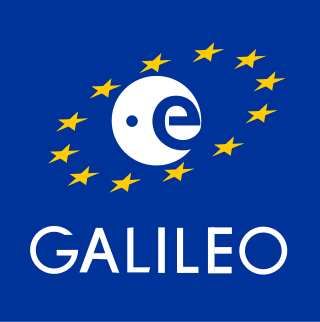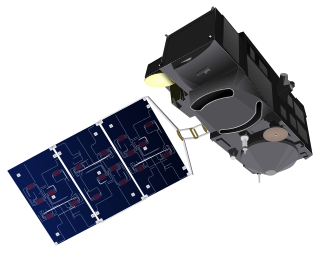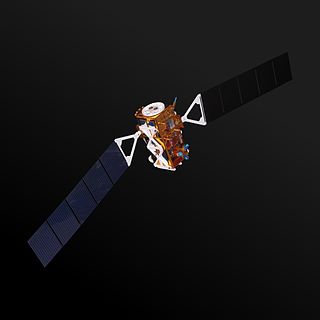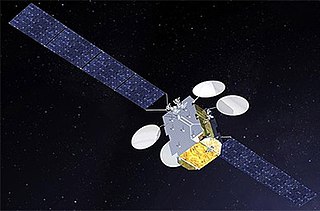
Ariane 5 is a retired European heavy-lift space launch vehicle operated by Arianespace for the European Space Agency (ESA). It was launched from the Guiana Space Centre (CSG) in French Guiana. It was used to deliver payloads into geostationary transfer orbit (GTO), low Earth orbit (LEO) or further into space. The launch vehicle had a streak of 82 consecutive successful launches between 9 April 2003 and 12 December 2017. Since 2014, Ariane 6, a direct successor system, first launched in 2024.

Galileo is a global navigation satellite system (GNSS) created by the European Union through the European Space Agency (ESA) and operated by the European Union Agency for the Space Programme (EUSPA). It is headquartered in Prague, Czechia, with two ground operations centres in Oberpfaffenhofen, Germany, and in Fucino, Italy,. The €10 billion project went live in 2016. It is named after the Italian astronomer Galileo Galilei.

Long-range optical wireless communication or free-space optical communication (FSO) is an optical communication technology that uses light propagating in free space to wirelessly transmit data for telecommunications or computer networking over long distances. "Free space" means air, outer space, vacuum, or something similar. This contrasts with using solids such as optical fiber cable. The technology is useful where the physical connections are impractical due to high costs or other considerations.

The Automated Transfer Vehicle, originally Ariane Transfer Vehicle or ATV, was an expendable cargo spacecraft developed by the European Space Agency (ESA), used for space cargo transport in 2008–2015. The ATV design was launched to orbit five times, exclusively by the Ariane 5 heavy-lift launch vehicle. It effectively was a larger European counterpart to the Russian Progress cargo spacecraft for carrying upmass to a single destination—the International Space Station (ISS)—but with three times the capacity.

BepiColombo is a joint mission of the European Space Agency (ESA) and the Japan Aerospace Exploration Agency (JAXA) to the planet Mercury. The mission comprises two satellites launched together: the Mercury Planetary Orbiter (MPO) and Mio. The mission will perform a comprehensive study of Mercury, including characterization of its magnetic field, magnetosphere, and both interior and surface structure. It was launched on an Ariane 5 rocket on 20 October 2018 at 01:45 UTC, with an arrival at Mercury planned for November 2026, after a flyby of Earth, two flybys of Venus, and six flybys of Mercury. The mission was approved in November 2009, after years in proposal and planning as part of the European Space Agency's Horizon 2000+ programme; it is the last mission of the programme to be launched.

The Meteosat series of satellites are geostationary meteorological satellites operated by EUMETSAT under the Meteosat Transition Programme (MTP) and the Meteosat Second Generation (MSG) program.

Spacebus is a satellite bus produced at the Cannes Mandelieu Space Center in France by Thales Alenia Space. Spacebuses are typically used for geostationary communications satellites, and seventy-four have been launched since development started in the 1980s. Spacebus was originally produced by Aérospatiale and later passed to Alcatel Alenia Space. In 2006, it was sold to Thales Group as Thales Alenia Space.

The Optical Inter-orbit Communications Engineering Test Satellite (OICETS), also called Kirari, was an experimental satellite launched by JAXA to demonstrate interorbital communication between satellites through optical (laser) means. OICETS was originally slated for a launch on the second J-I launcher. Due to problems with that launcher, the launch had to be put on hold. Using the H-IIA was out of question: it would have been overkill to use the H-IIA to send a 570 kilograms (1,260 lb) satellite into low Earth orbit, and there was no budget for another H-IIA launch. Finally, in order to be able to perform the tests during the lifetime of the European Artemis satellite, OICETS was successfully launched on a Russian-Ukrainian Dnepr rocket.

Thales Alenia Space is a joint venture between the French technology corporation Thales Group (67%) and Italian defense conglomerate Leonardo (33%). The company is headquartered in Cannes, France.
HYLAS is a British satellite in geostationary orbit. HYLAS, which is an acronym for Highly Adaptable Satellite, is a communications satellite and was launched by the European Ariane 5 launch vehicle from the Guyana Space Centre at Kourou in French Guiana. It is located at the orbital location of 33.5 degrees west and will provide new and innovative services including High Definition Television (HDTV) and interactive satellite delivered broadband services. The satellite will help address the issue of poor broadband coverage in many parts of Europe which have less developed ground infrastructure.

Alphabus is a family of heavy geostationary communications satellites developed by a joint venture between Thales Alenia Space and EADS Astrium Satellites in France, with support of the Centre national d'études spatiales (CNES), the French space agency and the European Space Agency (ESA).

Sentinel-3 is an Earth observation heavy satellite series developed by the European Space Agency as part of the Copernicus Programme. As of 2024, it consists of 2 satellites: Sentinel-3A and Sentinel-3B. After initial commissioning, each satellite was handed over to EUMETSAT for the routine operations phase of the mission. Two recurrent satellites, Sentinel-3C and Sentinel-3D, will follow in approximately 2025 and 2028 respectively to ensure continuity of the Sentinel-3 mission.
The European Data Relay System (EDRS) system is a European constellation of GEO satellites that relay information and data between satellites, spacecraft, UAVs, and ground stations. The first components were launched in 2016 and 2019.
The French space program includes both civil and military spaceflight activities. It is the third oldest national space program in the world, after the Soviet and American space programs, and the largest space program in Europe.

The Laser Communications Relay Demonstration (LCRD) is a NASA mission that will test laser communication in space for extremely long distances, between Earth and geosynchronous orbit.
Airbus Defence and Space is a division of Airbus SE. Formed in 2014 in the restructuring of European Aeronautic Defence and Space (EADS), Airbus SE comprises the former Airbus Military, Astrium, and Cassidian divisions. Contributing 21% of Airbus revenues in 2016, it is the second largest space company in the world.

Inmarsat-4A F4, also known as Alphasat and Inmarsat-XL, is a large geostationary communications I-4 satellite operated by United Kingdom-based Inmarsat in partnership with the European Space Agency. Launched in 2013, it is used to provide mobile communications to Africa and parts of Europe and Asia.

Sentinel-1A is a European radar imaging satellite launched in 2014. It is the first Sentinel-1 satellite launched as part of the European Union's Copernicus programme. The satellite carries a C-band Synthetic Aperture Radar which will provide images in all light and weather conditions. It analyzes many phenomena occurring on Earth, from detecting and tracking oil spills and mapping sea ice to monitoring movement in land surfaces and mapping changes in the way land is used.

Laser communication in space is the use of free-space optical communication in outer space. Communication may be fully in space or in a ground-to-satellite or satellite-to-ground application. The main advantage of using laser communications over radio waves is increased bandwidth, enabling the transfer of more data in less time.

Eutelsat Konnect is a geostationary communications satellite operated by Eutelsat. The satellite was designed and manufactured by Thales Alenia Space on the Spacebus NEO 100 platform, and was launched on 16 January 2020 on an Ariane 5 ECA. The satellite provides broadband internet and communications coverage to Europe and Sub-Saharan Africa.















